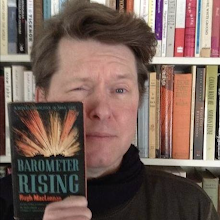Writes the anonymous newspaperman:
Epic in conception and execution, the procession depicted tableaux vivants, not only the eventful story of womanhood in Canada, from the early pioneering days, through the pageantry of historic crests to the present day, but also the larger tale of the Canadienne's lifetime, from cradle to the silvery locks of grandmotherhood.Jeanne Mance, Marguerite Bourgeoys, Mère Gamelin and Jeanne Le Ber, "first Canadian recluse", were honoured by tableaux, though I would be sacrilege to write that even one bore "the silvery locks of grandmotherhood." The same goes for Sœur Marie Morin, who is here recognized as the "first writer born in Canada":
The parade featured two other floats of a literary nature, the first of which was devoted to Evangeline. About that tableaux the Gazette reporter writes nothing… Maria Chapdelaine, on the other hand:
Then delightful Maria Chapdelaine came on the scene. Snow lay all around. The true, the proven Canadian country girl, she has become a known and idealized type.Here's another photograph of Maria's float from the 25 June 1931 edition of La Partrie:
The newspaper also provides a photograph of this tableaux commemorating Dame Emma Albani's private performance before Queen Victoria at Windsor Castle:
We fellas weren't left out; the parade featured this float, titled: "Arrivée de Mgr. Laval à Québec".
In truth, Laval arrived at Quebec by ship in 1659 (203 B.F.). I have nothing more to say regarding historical accuracy.
I wish there were more photographs of the floats. I expect they're out there somewhere. More than any other, I'd like to see that honouring Jeanne Le Ber. Whatever can a tableaux depicting a recluse look like?
Bonne Fête!



















